prosthetic
Latest
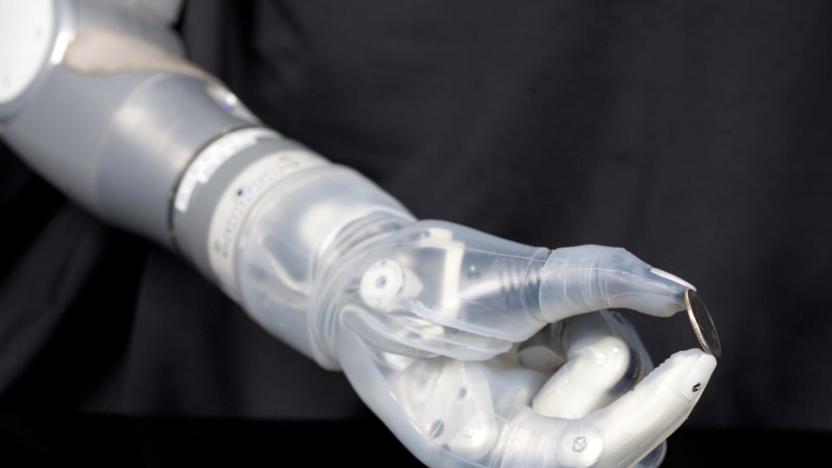
Segway creator's advanced prosthetic arm arrives in late 2016
Segway creator Dean Kamen's Luke prosthetic arm has been a long time in coming -- the FDA approved it two years ago. At last, however, it's nearly here. Mobius Bionics has revealed that it will offer the Luke arm sometime in late 2016. It's not clear what it will take to get one (you can register your interest today), but the features remain the same. The bionic wearable is all about offering the life-like dexterity that hasn't really been an option until now: you can hold a glass over your head without spilling it, for example, and the hand's mix of four motors and grip sensors can help you grab both very delicate and very heavy items. The odds are that getting one won't be trivial, but it might well be justified if it grants some extra freedom.

Cancer patient receives a 3D-printed jaw
If you lose your lower jaw to cancer, you don't have many options for prosthetics. At that size, traditional clay is so heavy and unwieldy that you can only wear it for a few hours at a time. Indiana University's Dr. Travis Bellicchi and team have developed a much better alternative, though. He recently gave tongue cancer patient Shirley Anderson a 3D-printed jaw after losing his natural jaw to the side effects of radiation treatments. The digitally-modeled piece is not only much lighter, but far more natural-looking -- the creators could create more natural borders and account for fine details like skin pores. The result is good enough that Anderson could comfortably wear the prosthesis in public without drawing significant attention.

Six gadgets made from LEGO bricks
By Cat DiStasio When kids play with LEGO bricks, their creations are limited only by their imaginations. A few colorful blocks can become a spacecraft, a bulldozer or a skyscraper with just a few moves. Although the LEGO builds from you childhood may not do much on their own, those colorful bricks lend themselves to amazing works of ingenuity when combined with other simple items. To showcase the vast potential of these cherished toys, we've rounded up a series of awesome gadgets made from LEGOs. Read on to learn about a working LEGO printer built by a teenager, a prosthetic arm that makes kids the star of any crowd and even a working LEGO camera that shows how it's possible to create almost anything if you want it badly enough.
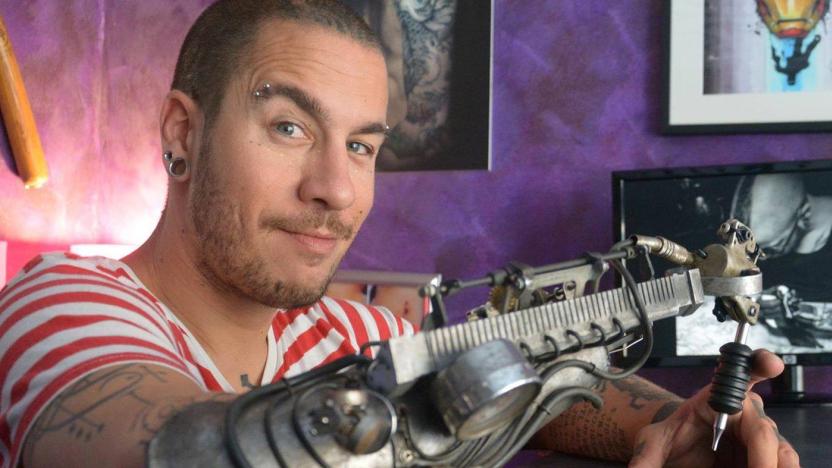
Tattoo artist's prosthetic inking arm is better than a real hand
If you wanted to be a tattoo artist but lost your drawing arm, what would you do? JC Sheitan Tenet has an answer: get a prosthetic arm that's better than flesh and bone. He teamed up with artist Gonzal on a steampunk-inspired limb that integrates an inking needle, a pressure gauge and piping. It's a makeshift combo of a regular prosthetic, a sewing machine and a turntable, but it's reasonably light and easy to use -- so much so that you might prefer JC's mechanically-assisted output over that of a good conventional artist.

Prosthetic arms inspired by 'Deus Ex' are coming next year
Remember that prosthetic arm, inspired by Metal Gear Solid, that Konami developed for a British amputee? Well, it seems the company has started a trend. Square Enix and Eidos-Montréal have now teamed up with Open Bionics, a specialist in low-cost prosthetics, to develop some designs based on the world of Deus Ex. The franchise delves deep into a possible future where human augmentation is commonplace, changing society and warfare in equal measure. Two arms -- one based on Adam Jensen, the hero of Mankind Divided, another on the wider Deus Ex universe -- will be released next year as royalty-free designs that anyone can use.
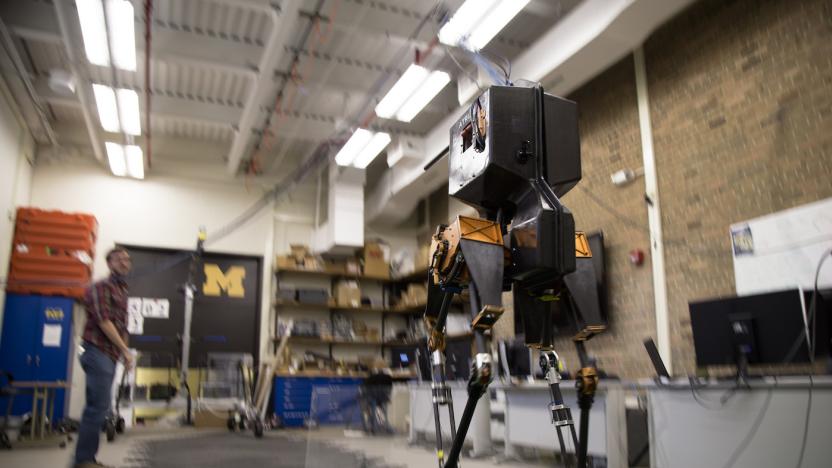
U of M's Marlo robot uses algorithms to conquer uneven terrain
Robots walking unaided on flat ground is tough enough as it is -- just look at last year's class of DARPA Challenge failures -- so when one can handle uneven terrain in any direction (not just a straight line), we take notice. The latest example is Marlo, a joint project between University of Michigan's Jessy Grizzle and Oregon State University's Jonathan Hurst. The key difference here is how it achieves this feat: a bank of algorithms containing different instructions for different walking styles.

Girl's superhero-inspired 3D-printed arm spews out glitter
When Jordan Reeves was given the chance to create her own superhero-inspired prosthetic arm, she conjured up something other 10-year-old girls can only dream of. She designed a cannon that can slip into her left arm that stops above her elbow and shoot sparkly ammunition: glitter. Jordan designed her "weapon" named Project Unicorn when she participated in nonprofit KIDmob's and 3D software company Autodesk's Superhero Cyborgs program in San Francisco. It connected kids with who needed prosthetic arms with engineers who helped them realize their own superhero-inspired designs.
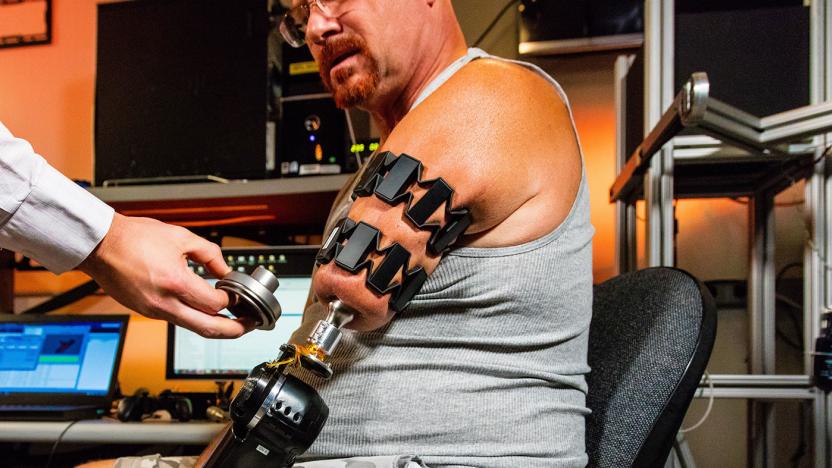
Researchers use Myo muscle-sensing wearable for prosthetics
Controlling Call of Duty or flying a drone isn't all the Myo armband can do. Researchers at Johns Hopkins University are employing the muscle-sensing wearable for a different application: prosthetics. With two of the gadgets, a patient is able control a prosthetic arm when he thinks about it. The pair of Myo bands on the upper arm read the electric impulses from muscle movement and wirelessly transmit them to a nearby computer. That computer determines what movement he is trying to make and tells the prosthetic arm to complete the task.

Derby the dog gets better 3D-printed paw prosthetics
Derby, the dog with 3D-printed legs, can walk straight and sit like any other pooch now, thanks to a new set of prosthetics. If you recall, South Carolina company 3D Systems created his initial pair to be close to the ground so he could get used to them without hurting himself. Since merely blowing the old version up didn't work quite as well as the company had hoped, the team decided to design new ones.

Scientists make an artificial heart out of foam
Artificial hearts only kinda-sorta behave like the real thing. They pump blood, sure, but they're typically solid blocks of machinery that are out of place in a squishy human body. Cornell University thinks it can do better, though: its scientists have developed an artificial foam heart that imitates both the functions and shape of its fleshy counterpart. The key is a new polymer that can be poured into specific shapes, and has pores that let it pump fluids. It's not only soft and stretchable, but more efficient -- you don't need much energy to get liquids moving.

Young amputees will soon get 'Iron Man' and 'Star Wars' bionic hands
A heroic set of prosthetic hand designs will soon allow young amputees to transform into their favorite Disney characters. Whether they prefer a red Iron Man gauntlet, one of Queen Elsa's sparkling blue gloves or a hand inspired by Star Wars' iconic lightsabers, they'll be able to take on the world with a prosthetic that finally marries form and function. The three models have been created by Open Bionics, a startup working on cheap, 3D-printed hands for amputees. Joel Gibbard, the company's founder, says they'll cost around $500 and be available in 2016. Another, non-Disneyfied design should be roughly £2,000 ($3,071) -- considerably more, but still a fraction of what many existing prosthetics cost.

Prosthetic hand restores a man's sense of touch
DARPA promised prosthetic limbs that produce realistic sensations, and it's making good on its word. The agency's researchers have successfully tested an artificial hand that gave a man a "near-natural" level of touch. The patient could tell when scientists were pressing against specific fingers, even when they tried to 'trick' the man by touching two digits at once. The key was to augment the thought-controlled hand with a set of pressure-sensitive torque motors wired directly to the brain -- any time the hand touched something, it sent electrical signals that felt much like flesh-and-bone contact.

Bionic leg climbs stairs with ease
As advanced as prosthetic feet and legs have become, they're frequently lousy with stairs. You usually have to reconfigure your limb to make the climb, even if it's just for a few seconds. That won't be an issue again if the Rehabilitation Institute of Chicago's efforts pay off, however. Its researchers have built a new bionic leg that lets you climb stairs, kneel and otherwise move freely without straining yourself. It revolves around a control system that tells what you're trying to do and adjusts automatically, letting you focus on walking instead of terrain changes. The leg is only in a very limited test run backed by the US Army, but it's expected to become a commercial product that helps amputees of all stripes. [Image credit: Ann Simon/Rehabilitation Institute of Chicago]

Prosthetic foot only needs 'mind control' for movement
During a press conference in Copenhagen on Wednesday, prosthetics manufacturer Ossur announced the release of an implantable sensor that allows users to mentally control a mechanical limb. The technology, known as an Implanted MyoElectric Sensor (IMES) will allow users to move the company's motorized Proprio Foot just like they do the real thing.

Wounded turtle can return to the ocean thanks to a 3D-printed beak
Look, we know this sea turtle's prosthetic beak has a tragic backstory, but it sure makes the reptile look like it has a future as a badass pizza-loving mutant. According to 3D Printing Industry, Turkish animal rescuers found it almost lifeless at sea, after a boat propeller shaved off a huge part of its snout. It escaped the clutches of death thanks to those kind folks, but a turtle that has to be hand-fed can never survive back in the wild. That's why the organization contacted 3D printing service provider BTech Innovation, which took the turtle's CT scans to create a beak that would fit it perfectly.

'Thinking cap' controls prosthetic arm with thoughts, not surgery
The ability to control prosthetics with only the power of your mind has been around for a while, but it typically requires control electronics implanted directly into the patient. With this new, non-invasive method developed at the University of Houston, however, amputees can command their robotic limbs without surgery. Instead of implants, the UH system uses a wearable "thinking cap" (aka an EEG) that monitors brain activity externally through the scalp. A brain-machine interface (BMI) then interprets these brain waves and converts that intention into mechanical motion. Basically, the patient thinks about picking up an object, the BMI recognizes the intention and then tells an attached prosthetic to do so. Even at this early stage of development, University of Houston researchers have gotten the system to work properly 80 percent of the time.
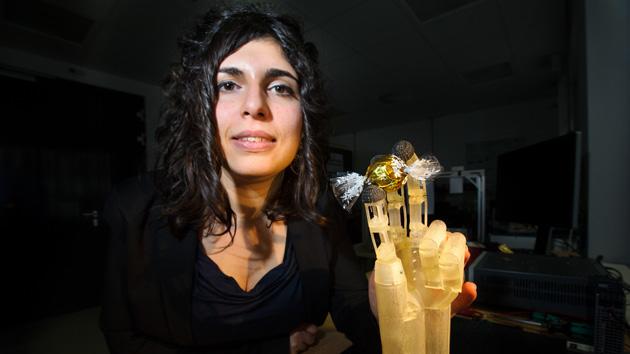
Super-precise artificial hand uses smart wires as muscles
As a rule, bionic hands are clunky contraptions made of motors, pneumatics and other machinery that just can't be as elegant as the real thing. Germany's Saarland University might just change that, however. Its researchers have developed an artificial hand that uses smart nitinol (nickel titanium) wires as its muscles. All you do to make them flex is heat them up or cool them down -- the metal 'remembers' its original shape before you bend it, so you don't need bulky equipment to move it back and forth. The wire bundles are as thin as cotton, but they're very strong and can move with much more precision and speed than usual. They don't even need sensors, since electrical resistance in the wires themselves is enough.

This $300 cybernetic arm gets its smarts from your cellphone
Iron Man isn't the only one 3D-printing artificial limbs these days. But unlike the mechanical hand delivered by Robert Downey Jr, this recently unveiled prosthetic from Japanese manufacturer Exiii costs just $300 and leverages your mobile device's computing power to act just like the real thing. The Ghost in the Shell future we've between waiting for came took a step closer to reality.

Cyberlegs project wants to equip amputees with robotic limbs
You'll see a lot more instances of robotic arms in the news, but it doesn't mean high-tech prostheses for the lower limbs don't exist. The Cyberlegs project, for instance, is developing robotic legs that can help amputees move and walk more naturally. Each system is comprised of smart shoes equipped with pressure sensors and inertial measurement units, the limb itself, as well as a component and algorithm that can decode how the user intends to move. It can, for instance, tell if the user wants to start walking, to get up or to sit down -- based on the amputee's habits -- providing the proper support for each action. Users that need even more help can also be fitted with an accompanying pelvic brace that can assist them in moving their hips.

Derby the dog got 3D-printed paw prosthethics, now watch him run
Derby was born with deformations in both of his front legs, making movement and any kind of speed difficult, if not impossible. Now, he can run. The husky mix was fitted out with two prosthetics, custom-made on 3D sculpting software to fit his forearms. With some help from 3D Systems and several iterations later, and the curved prosthetics you see above became the final build. "The great thing about using 3D technology in Derby's case, is having these images on file on a computer, and being able to print them. [It] is a lot quicker than having to hand sculpt every single mold and rebuild these braces five to ten times," explained Kevin Atkins, 3D Systems' Freeform Product Manager. The team settled on these curved designs because there was the fear that more pointed iterations (like running blades seen on humans) would get caught in softer ground.







